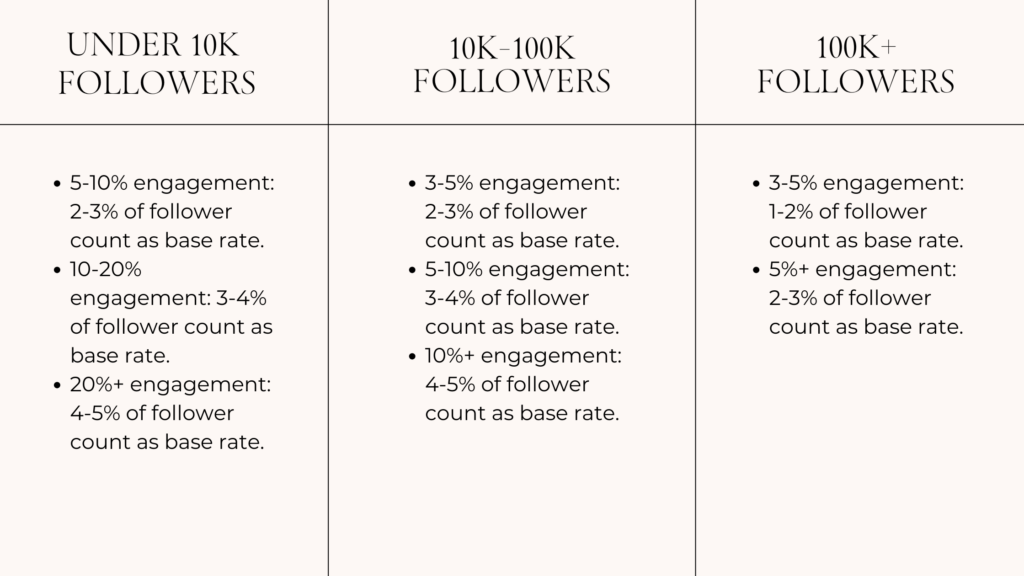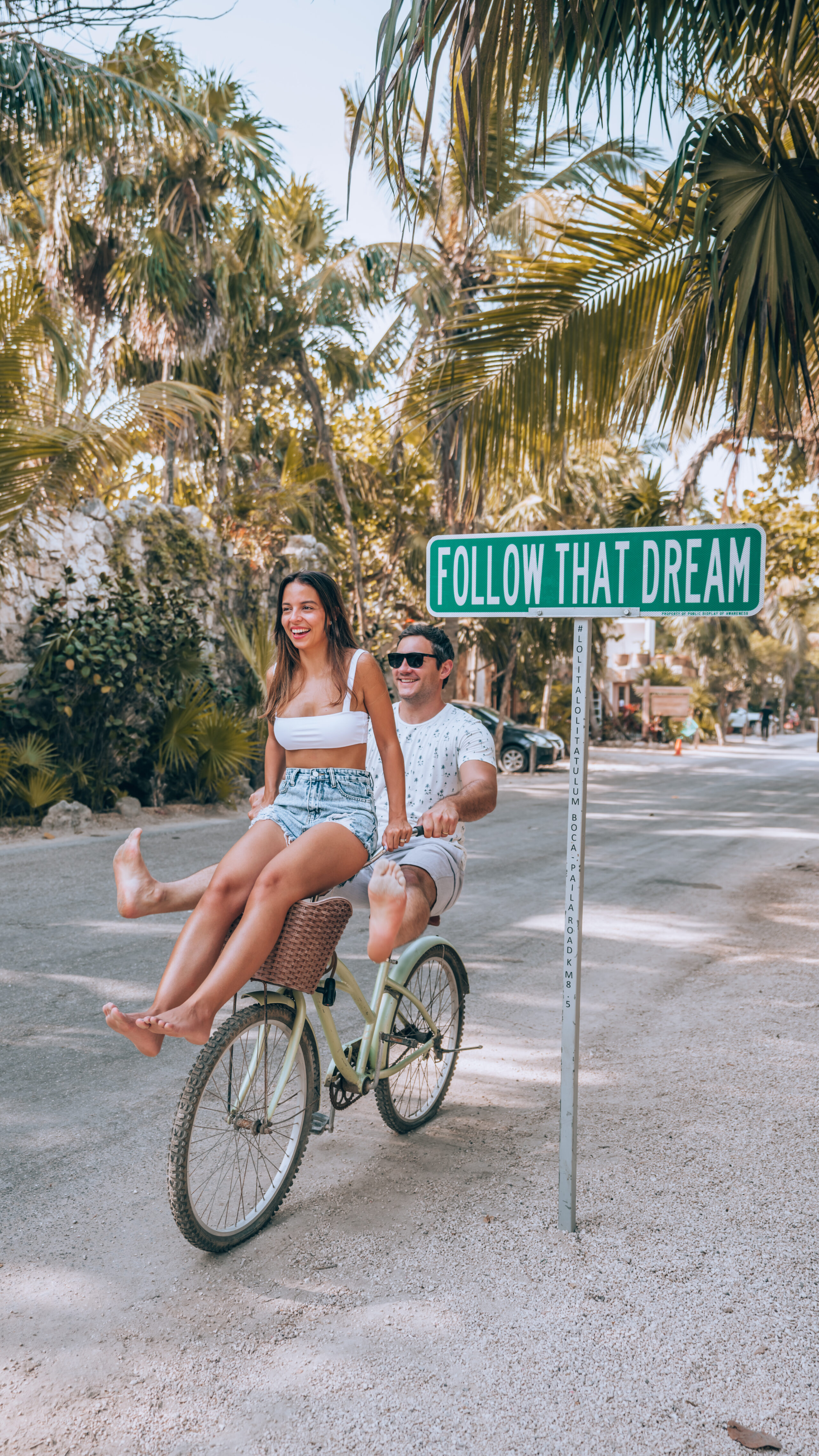Pricing yourself as an influencer can feel daunting, whether you’re just starting out or are an experienced content creator. With so many variables—from audience size and engagement rates to content deliverables and licensing—it’s easy to feel overwhelmed. There’s also the added pressure of a thousand voices on social media, claiming to have the perfect pricing formula. However, understanding how to navigate influencer rate setting is crucial for building a sustainable career in this fast-growing industry. And having the tools to make the most informed decision for yourself is key to feeling well-compensated and appreciated for your work and time. In this guide, I’ll walk you through a baseline formula, along with actionable influencer pricing tips and strategies to price yourself confidently and attract brands that value your work.
Why Influencer Rate Setting Matters
Before we get started, I want to make it absolutely clear that there isn’t a magic number to set your rates at. You’ll find a lot of content claiming that having a certain number of followers means you’ll charge a certain dollar amount. But it isn’t so black and white. There are a number of factors to consider when setting your rates. This blog post walks you through all the common pricing strategies and considerations, but at the end of the day, you need to do what feels right to you.
Gifted Collaborations and Unpaid Partnerships
Your rates not only reflect your worth but also set the tone for how brands perceive and collaborate with you. Working for free or undercharging might seem like a way to gain experience or build a portfolio, but it can pigeonhole you into the “will work for free” category. PR and brand managers often share insights, and you don’t want to be commonly known as someone who will offer discount (or free) services – and trust me, this definitely happens.
With that being said, there are four scenarios where unpaid collaborations might be worth considering:
All-expense-paid press trips
Typically, the cost of a press trip is covered entirely by the brand. That includes flights, airport transfers, hotels, experiences, and meals. While paid press trip opportunities are out there – I’ve personally done several – depending on the destination and the alignment with your audience’s interest, it’s an opportunity worth considering.
No strings attached giftings
Receiving a gifted product without the obligation of posting or creating content is another exception. Still today, if a brand sends me a PR package without the obligation of posting or content creation, I would try the product to see if it’s something I would genuinely recommend. If I really like the product, I might share it with my audience if it makes sense and if it fits my content plan. The point is that the brand sends a PR package or product without the expectation of a free promotion or work.
Collaborations supporting nonprofits or small local businesses
This is a fantastic way to give back to your community. It’s something I actively participate in and recommend all my students to do, too.
Product value exceeding your usual fees
Like I mentioned, if the product is something you were planning on purchasing anyway, accepting a gifted product in exchange for a post or stories could make sense if the product value exceeds your usual promotion fees. However, I’d warn against making a habit out of it so that you can maintain the standard of getting paid for your work.
What To Do If a Brand Says They Have “No Budget”
Very often new influencers will receive an email or response (to a pitch) claiming that they have “no budget” to compensate for your work. This statement means one of two things: either they don’t understand the value of your offer (a problem that can often be addressed with a well-crafted proposal that highlights and demonstrates your creative input), or they’re attempting to get some assets for free.
This is why I stress with my students the importance of recognizing their value. As I stated at the beginning of this blog post, once you’re commonly known in the industry as a creator who would accept an unpaid/underpaid opportunity, it could become difficult to raise your rates and break out of the trap of working for free.
Influencer Pricing Tips for Common Collaborations
Let’s get into the finer details of setting your rates as an influencer and pricing your work. Again, I’d like to highlight that pricing is highly subjective and there’s a lot of nuance that goes into setting your rates. With that being said, I know that you have questions about what’s standard in the industry so you’re not setting your rates blindly and excluding yourself from what’s considered reasonable.
This blog post might not be able to tell you exactly what your rate should be, since I can’t get an intimate look at your content, engagement, and following… But it’ll give you the tools to appropriately calculate the range that’s suitable for your work.
Product-for-Post Deals
This is often the first type of collaboration nano and micro-influencers encounter. In exchange for a product or service, you deliver agreed-upon content—e.g., two clothing items for one Instagram post.
These collaborations usually begin at around 5,000 followers and deal with an exchange of product as compensation, not a cash payment. See the part above about when to accept these brand deals.
Sponsored Posts (Static images, Carousel posts, and Reels)
When it comes to sponsored posts, you’re paid a fee on top of receiving the product or service. Use this basic formula to calculate your base rate, but keep in mind this number will need to be adjusted based on your follower count and engagement rate (more on this later in this post). Finding your base rate is just step 1, and should not be your final rate:
- Static image: $100 per 10k followers.
- Carousel posts: Add 10-30% per additional image.
- Reels: Add up to 30% for video content.
These are just the industry standard base rate formulas. Size of your account, engagement rate, usage and other add-ons typically play a role in negotiating your payout, which I’ll discuss later in this blog post.
Sponsored Stories
Once you know your base rate, sponsored stories normally allow you to charge between 15-30% of that rate for 2-3 frames. Additionally, if you’re linking directly to a product or site within those story slides, you can charge an extra fee.
For example, with a base rate of $500, a story set could range from $75 to $150.
Giveaways
Giveaways often involve brands providing a product or experience to both you and your audience. Compensation is usually higher due to the promotional value. For influencers with over 5,000 followers, fees typically include 20-30% on top of your base rate.
Press Trips
These are organized by brands or tourism boards to promote destinations or products. While many are unpaid, you want to make sure that the deliverables expected align with the value of the experience.
I’ve been on many trips where I was getting paid on top of having all expenses covered. And other creators weren’t because they rushed to accept the opportunity and didn’t push to get compensated for their work. I recommend charging your regular rates for press trips (based on the deliverables they’re asking for). But being open to giving a package discount depending on the value of the trip you’re invited to.
Remember, even if the opportunity is unpaid and you’ve decided to accept it, you can always negotiate down the amount of deliverables that you’re responsible for.
Adjusting Your Rates: Engagement is Key
Engagement rate and follower count plays a significant role in determining your worth. Contrary to what many believe, the smaller your audience, the more you can charge proportionally to your follower count. That’s because nano and micro creators often have tighter-knit niched communities. This means audiences trust their opinions more than they do big accounts that are seen as celebrities.
Here’s a guideline to adjust rates based on engagement levels:

Let’s look at some examples of what this might look like:
Say, for instance, a creator has 7000 followers, with a 6% engagement rate. The rate formula to use will be in the under 10k followers category, within the 5-10% engagement → 2-3% of follower count as base rate.
We can then determine the percentage of follower count for the base rate by doing some quick math:
- 2% of 7000 = 7000 x 0.02 = 140
- 3% of 7000 = 7000 x 0.03 = 210
That means this influencer’s final base rate range would be between $140 and $210.
Here’s another example:
If a creator has 5300 followers and a 25% engagement rate, we’ll use the following rate formula of under 10k followers, which is: 20+% engagement → 4-5% of follower count as base rate
Since this influencer’s engagement rate is 25%, the influencer can consider 4-5% of their follower count in the calculation of their base rate, which works out to be:
- 4% of 5300 = 5300 x 0.04 = 212
- 5% of 5300 = 5300 x 0.05 = 265
Making the base rate for this influencer in the range of $212 – $265
Add-Ons to Consider
1. Link in Bio: Charge 25-30% of your base rate per day. For example, with 50k followers and a base rate of $500, a 24-hour link in bio placement could be $125-$150. If the link will be part of a linktree and not the only link listed in your bio, charge 15-20%.
2. Whitelisting and Amplification Rights: Brands may boost your content as ads, using your face and likeness to gain trust and engagement. Charge an additional 20-50% per post or story per month of whitelisting.
3. Content rights and licensing: For social rights, add about 15-20% of your base rate per month, per piece of content. For website, newsletter or ads, add 20-35% of your base rate per month.
For larger brands or key placements like homepages or billboards, fees can reach $5,000 or more.
4. Exclusivity Agreements: Exclusivity limits your ability to work with competitors. Calculate fees based on:
- Length of exclusivity.
- Missed revenue opportunities.
- Specificity of category (e.g., all fashion brands vs. one competitor).
On average, charge 50-100% of your base rate per month for exclusivity for a category that is relevant to your business.
Building Confidence in Your Pricing
The topic of money, fees, and rates can make even the most experienced of influencers uncomfortable. Especially in a creative field like content creation, there isn’t a one-size-fits-all rate that perfectly considers your skills, hours spent on work, audience size, and all the other bells and whistles.
Building confidence in your pricing takes practice, but here are 3 tips to help you get more comfortable:
- Know Your Worth: Your time, creativity, and audience have immense value. Don’t undervalue yourself out of fear of losing opportunities.
- Customize Proposals: Tailor each proposal to the brand’s needs, and never include rates in your media kit.
- Stay Professional: A well-designed proposal showcases your credibility and helps justify your rates.
Wrapping Up
Influencer rate setting isn’t about finding the perfect formula but understanding your unique value and communicating it effectively. By using these influencer pricing tips, you can confidently price yourself, attract meaningful collaborations, and build a career that’s both fulfilling and financially rewarding. Remember, pricing is a reflection of the value you provide—so don’t be afraid to own it proudly.

+ show Comments
- Hide Comments
add a comment